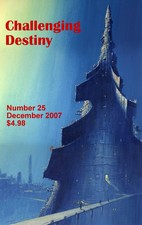


Reviews Home
Columns
Fiction by Title
Fiction by Author
Nonfiction
Movies by Title
Movies by Rating
Audio
Games
The Wall Around Eden, Joan Slonczewski, Avon, 1989, 288 pp.
The phrase "post-apocalyptic" has become a derogatory label due to overuse in the genre. Whether it's a nuclear winter or kids stuck on an island without any grownups, the situation is always the same, and the theme is always the same. Humans revert to savagery, men become macho hunter-killer types, and so forth. If it's a movie, the studio gets to save lots of money on costumes and sets (compared to other films set in the future) and use stock footage of nuclear explosions. There's a nuclear war twenty years before The Wall Around Eden, but Slonczewski is exploding all these stereotypes, not using them. As we have come to expect from this writer, we get a strong narrative, fascinating characters, and a good deal to think about after we set the book down.
Isabel Garcia-Chase is a young citizen of the Gwynwood Enclave, and while the book is written in third-person, we get most of the information filtered through her perspective. The Enclave has been set up by aliens, in order to "protect" the humans from the radioactive fallout from the Death Year. But few humans are happy with these unseen alien intelligences, and Isabel is one of those acting on rebellious feelings against the makers of the Enclave. Gwynwood is largely a Quaker community, and this kind of defiance does not sit well with the other people. But it becomes routine for Isabel, and she eventually wins through to the other side of the aliens' communication/transportation pylon. That is only a small part of her coming of age, and part of Slonczewski's genius is her portrayal of people going about their day-to-day business in the face of absolute turmoil and strangeness.
Slonczewski's Quaker concerns are well-represented in the plot construction, but also in the characterization, especially in the way we see the concerns that motivate people. She also cleverly avoids making this a suffocating message by bringing us into the story with Isabel, whose rebelliousness makes her ready to chuck her Quaker heritage. Slonczewski uses this outsider character to good effect with the contrast between Isabel's father, who arrived in Gwynwood many years before the novel opens, and Keith, who is sent by the aliens to Gwynwood halfway through the book. These two outsiders, as well as Isabel, get absorbed into a close-knit society, change it and are changed by it in return. One of the strongest tools Slonczewski wields is the big events of life -- birth, death, marriage, and so on. As in Still Forms on Foxfield, she shows how these things happen in a working community, as a way of drawing us in -- into her frame of reference, into her argument. The power of primal rhetoric.
A big break happens in the narrative about two-thirds of the way through the book, when Isabel and two others make it through the pylon into some sort of alien construct in orbit around the Earth. At first, it seems like all the character buildup in the first half of the book is wasted because only three people end up in the hypersphere. But Slonczewski is a cunning writer, and we soon realize that this too reinforces her theme about our environment shaping us. She again points to the fact that our community steers our actions, whether we act with it or react against it. It takes a while for this to sink in, because science fiction is such a strong holdout for the notion of individualism, with the scientist as ultrahero (or ultravillain), and even the normal person as some kind of Heinleinian Competent Man. In this book, no one acts alone. Villainy is species wide, as a societal tendency, and decent people cannot function in a vacuum. The aliens are part of a societal hierarchy... but I don't want to give away the ending. Suffice it to say, Slonczewski makes a strong statement.
I've read The Wall Around Eden twice now, and I was struck by how the ending creeps up on the reader in a different way than in a non-Slonczewski book. The typical road signs for an approaching denouement are inapplicable here. In other words, no buildup to an apocalyptic climax, with heaps of destructive violence. No bad guys getting immolated, no crowds cheering in bloodthirstiness. Instead, we get something much more realistic. More bleak and austere, and at the same time, more refreshing and invigorating. We are only humans, and to find out the truth about the past and how an alien species works -- this is perhaps too much to ask of reality. The glimpses we get are fascinating enough and frustrating enough that we become perfectly identified with the characters. Quite a feat.
Some nitpicky items. I found that Slonczewski's treatment of homosexuality was somewhat awkward, but I'm not sure how much that reflects her own views and how much the views of Isabel. I was also jarred by her way of making cultural allusions, even though it's nice to know Slonczewski is fan of The Dispossessed. She also uses a famous short story by Heinlein to explain the alien hypersphere. She meant well to include these things, and they add to her book, but she needed to smooth out her handling of them.
Overall, The Wall Around Eden is an interesting and offbeat read. In some ways, like any post-apocalyptic story, the set-up is a loaded question, a what-if that is rhetorical in its answer. What is human nature? Well, we've already destroyed our planet. But that's a general complaint about this subgenre, and Slonczewski's take on the subject is sufficiently unique.
First posted: February 2, 1998; Last modified: February 18, 2004
Copyright © 1998-2004 by James Schellenberg (james@jschellenberg.com)

Buy back issues of Challenging Destiny online from:
For the latest information on availability: Where Can You Buy Challenging Destiny?